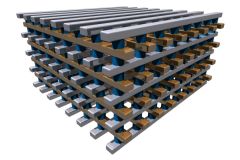As we rely more on phones and tablets for our computing needs, it seems like we’re always running out of storage. Most mobile devices top out at 64GB, and while you might see a tablet with 128GB of 256GB of storage, that’s still a long way from the terabyte or more that you find on even the most basic laptops and desktops.
The problem lies with solid-state, or flash-based, storage, which is found in almost every phone and tablet. Flash storage is faster and more power-efficient than traditional hard drives, but it’s much more expensive, and as storage size increases, flash storage is more prone to breakdowns. What we really need is a breakthrough.
Fortunately, there are two of them on the horizon.
Samsung, the world’s largest maker of memory chips, has created a “3D Vertical NAND” flash chip that supposedly sidesteps the reliability issues of existing flash storage.
Instead of putting memory cells on a conventional 2D plane, the company reworked its long-serving Charge Trap Flash technology to create a 3D cell structure with more breathing room. The result is flash that improves both reliability and speed at higher densities; Samsung claims that the new technology is 2-10X more reliable than its ancestors, and twice as quick at writing data.

Ars Technica points out that the technology could scale up to create a 1-terabyte solid state drive.
Meanwhile, other companies are looking beyond NAND flash for a true successor. A new company called Crossbar claims to have a solution, called Resistive RAM.
The company can put a terabyte of data, or about 250 hours of high-definition movies, on a single chip that is smaller than the equivalent flash memory chip (as pictured at top). It could also perform its storage functions at 20 times lower power, extending the battery life of devices using it to weeks, months, or years. Crossbar also says it has 10 times the endurance of NAND flash chips that it could replace.
It sounds too good to be true, but apparently Crossbar has built a working memory array in one of its partners’ manufacturing plants, proving that the technology could be produced without creating new facilities.
ExtremeTech provides some extra context, noting that larger companies like Panasonic, HP and SK Hynix are all working on their own ReRAM designs. It seems like ReRAM is going to be the next big storage format; it’s just a question of timing:
The current hope is that ReRAM will be ready for widescale adoption by the 2017-2018 timeframe. The first 3D NAND devices are currently expected in 2015, which means commerical ReRAM deployment would begin well before NAND hits its absolute scaling limit. Given the difficulty of ramping an entirely new technology, it wouldn’t surprise us if NAND’s last generations focus primarily on low-end consumer applications, while ReRAM comes in at the top for the enterprise market, where endurance and write requirements are difficult to meet with smaller NAND geometries.
To put it all another way, it’ll be at least a few years before we’ll see the fruits of these new technologies.
To some extent, the rise of online storage reduces the need for lots of on-board storage, but it’s not a total replacement. As mobile apps get more sophisticated, and make use of higher-resolution images and video elements, we’ll need more space to hold them all. The value of backing up our most precious files locally, and not just online, isn’t going away either. We definitely need a lot more on-board storage for our phones and tablets. It’s good to know that the future holds more than incremental improvements.

